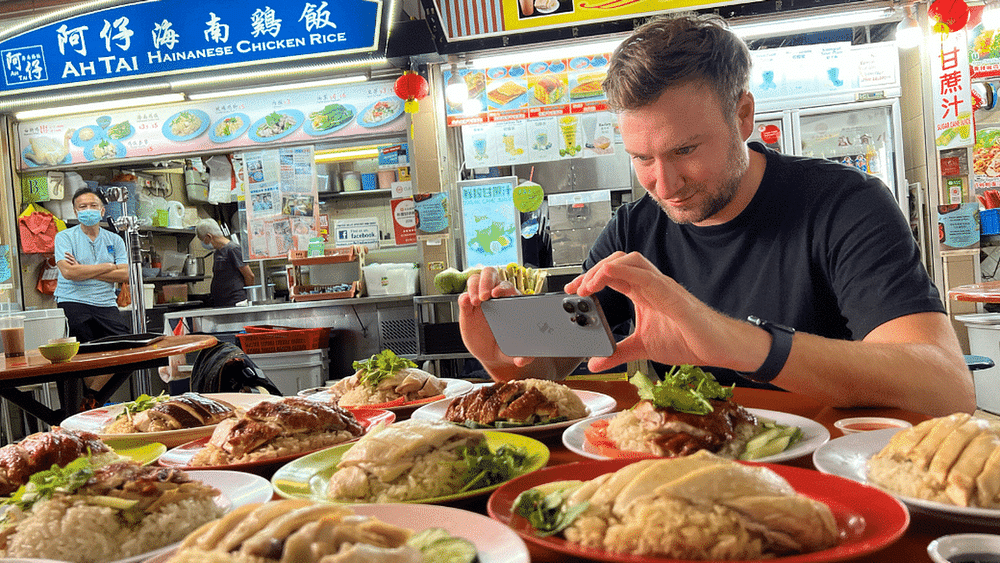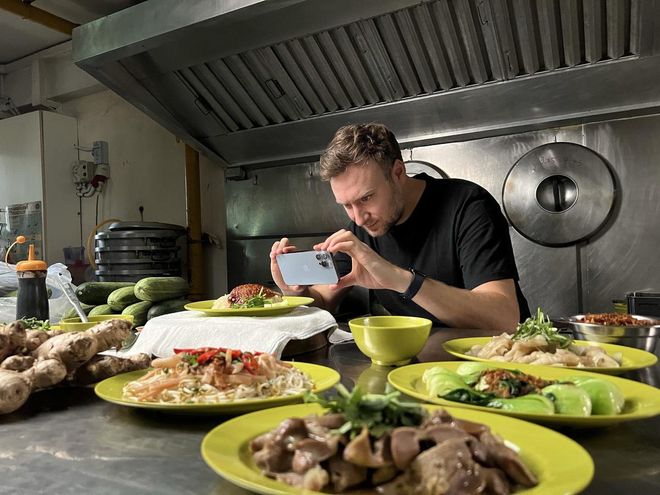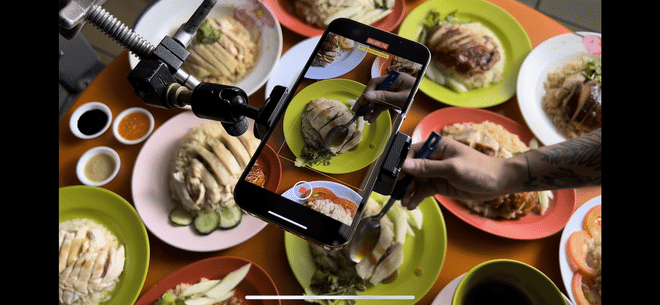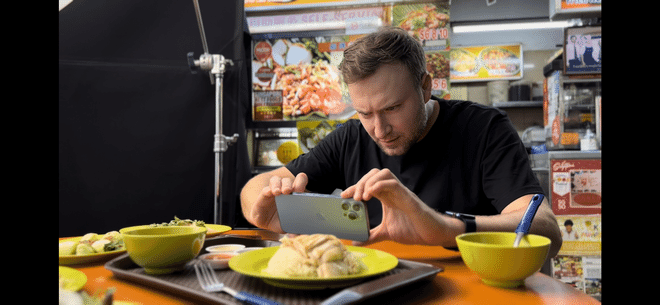David Gelb On Directing Apple’s First Singapore-Based ‘Shot On iPhone’ Campaign
Gelb speaks on creating a cinematic food documentary using iPhone 13 Pro, his favourite food destinations, what he hopes audiences will take away from this film and more.

Over the years, we’ve collectively marvelled at the cinematic Shot On iPhone campaign films, such as the Apple Chinese New Year film, The Comeback, as well as at the device’s image-capturing capabilities. The film, directed by Chinese screenwriter and director Zhang Meng and shot entirely on iPhone 13, follows the story of a father, son and forgotten village with their dream. Now, for the first-time ever, the California-based tech giant has released a brand new documentary focusing on Singapore. Aptly titled Poached, and directed by acclaimed food documentarian David Gelb, the short celebrates Singapore’s UNESCO Heritage hawker culture.
The documentary, also shot entirely on iPhone 13 Pro, spotlights Singapore's local cuisine through the rich history—and competition—between two chicken rice stalls: Tian Tian and Ah Tai. It’s a contemporary take on the classic generational conflict of the old guard against the new player. It tells the story of our nation’s shared love for the dish, food culture, the people and their passions.
Related article: Best Places To Get The Most Authentic Korean Food In Singapore

Photo: Apple
David Gelb On Directing Apple’s First Singapore-based ‘Shot On iPhone’ Campaign
Related article: Food For Good: 10 Ways Food Is Uniting Singaporeans
For the uninitiated, Gelb first rose to prominence with his feature-length tribute to sushi chef Jiro Ono in Jiro Dreams of Sushi. Gelb is also the creative genius behind Netflix’s Chef Table as well as Disney’s Wolfgang. His idiosyncratic method of storytelling combined with Hollywood-style cinematic shots make his audiovisual projects incredibly informative and a delight to watch. In other words, infotainment at its best.
In an interview with BAZAAR, Gelb speaks on creating a cinematic food documentary using iPhone 13 Pro, his favourite food destinations, what he hopes audiences will take away from this film.
Related article: Chef Lennard Yeong Makes A Case For Pursuing What You Love And The Power Of Food
When you were first approached to direct this short, what was the first thing that came to mind?
It was to see if we could shoot a short film, in the same way that we did Chef’s Table and Street Food (my shows on Netflix), using an iPhone. And when you have a really great story, like this one about two incredibly passionate hawker vendors, the dramatic story between them, beautiful food, you’re able to make a very interesting film. It was a very exciting opportunity.
I was thrilled to go and immerse myself in the hawker culture, eat at hawker centres every day and be able to film in a very free and liberating way using the iPhone but still being able to get a very cinematic image. And so that was what we were really trying to do. And I hope that we were successful.
Having directed the documentary Jiro Dreams of Sushi and being the creator of Netflix’s first unscripted original series, Chef’s Table, you’re obviously no stranger to telling food stories in an authentic manner. What about this project drew you in the most, and what ultimately made you decide to take this on?
I think both the opportunity to use iPhone 13 Pro to make a film, and to have the support from Apple to do so really influenced my decision to take this on. My team and I worked with a production company called Independent Media—owned and run by Susanne Preissler, who’s a fantastic producer—and we thought: ‘Okay, let’s go. Let’s use our highest end style of shooting. But we’ll use an iPhone,’ and that was really the task at hand.

Photo: Apple
David Gelb On Directing Apple’s First Singapore-based ‘Shot On iPhone’ Campaign
What challenges did you face and how did you overcome them?
I think that the iPhone was one of the things that really helped us, in this case. There were a few factors, such as cinematic mode, which made the footage really look like a movie. In contrast, a conventional movie camera is many times more expensive, larger and bulkier. So when you have that cinematic capability on a small compact sized device, it helps with the biggest challenge of all: Shooting in a very small, crowded space.
These hawkers don’t waste an inch of their kitchen space. There’s something going on everywhere. Somebody’s poaching a chicken in a vat of water here, boiling broth there, vegetables being cut up and sauces being made. It’s like organised chaos. And so there was no room for us to come in as a crew with a conventional camera without disrupting their business. We wanted to do it in a way that was very authentic yet non-disruptive. The iPhone helped us meet that challenge because of its low profile, and high-quality image.
As a well-known director used to working with an array of cinema-quality equipment, what aspects of shooting on an iPhone surprised you the most? And what tips or tricks would you like to share with iPhone users?
I think that a big part of image-making is location. You’ve got to ask yourself: ‘Where am I? And where’s the light?’ I think one of the great things about the iPhone is that it allows you to capture very professional-grade looking photos and videos without needing all of that gear.
The iPhone 13 has a fantastic low-light shooting mode. But still, I’d suggest finding an area that doesn't have a bunch of messy shadows. So choose your table wisely. I think when it comes to shooting food, opt for somewhere near a window or a nice light source. These are things that can help quite a bit.
I also like to recommend that people shoot close to the table. If you're shooting a video, cinematic mode is great because you're able to choose the focus (such as on the food) and let the background kind of fall out of focus, and that gives a very studio quality, and a professional look to it. If you're doing a still, use portrait mode. Using these tools that the iPhone has wisely definitely helps.

Photo: Apple
David Gelb On Directing Apple’s First Singapore-based ‘Shot On iPhone’ Campaign
Apart from celebrating Singapore's hawker culture, what else was important to you to include or highlight in this campaign?
I think we wanted to tell a personal story about passion. We wanted the hard work and legacy of these hawkers to shine through. They work very hard, have strong convictions about doing things their own way, and we really wanted to show that with a certain dignity and respect.
We wanted to have a fun tone to it as well, because it’s chicken rice. It’s something that people love and are excited about, so we wanted to make sure that it was something fun to watch too. Also, it was important to be true to the characters, and to portray them with respect. So we want to keep to a tone that's entertaining, informative, and emotional with lots of beautiful images. These were our priorities coming into this project.
How would you describe your style of storytelling, and what is your creative process like? Did you do anything different with this project?
We followed our normal process where the character and their story comes first. When you’re making something about food with a chef who’s very passionate and has a personal story that’s emotional, it’s universal. People can identify with someone going through hard times and who manages to emerge on top of it. The story has to come from the character. In this case, we have Madam Foo handing down her legacy to her daughter. And you have someone else who has learned from her as well, and now makes chicken rice in his own style.
Characters are the most important thing, and food is the extension of the character. That's the representation of the passion. And so we always look for a great story first, then delicious food and visuals that come from that story.

Photo: Apple
David Gelb On Directing Apple’s First Singapore-based ‘Shot On iPhone’ Campaign
While you were in Singapore, what other hawker cuisines did you try and which were your favourite?
I ate so much and I tried a lot of different things: Laksa, incredible satay, chilli crab and a lot of the staples and most famous dishes. I love chicken rice because of its simplicity, and the flavour of chicken. The chicken rice at Tian Tian and Ah Tai are so tender. The rice is so fluffy, delicious — just perfect. The sauce is amazing, too. I like it very spicy, so I like to put a lot of the chilli and brown sauce.
I also love Maxwell Food Centre. One of my favourite things to eat there was duck rice, which is very delicious. A tip given to me was to find the queue, and then wait for the best thing. So I was looking around and was like ‘wow, this is like a strong queue.’ I got in line with all these people who were excited for the dish and it was a lot of fun. It feels like you’ve kind of earned your meal by waiting patiently.
Having tasted many glorious noshes by talented chefs around the world, what are your top must-visit destinations for food lovers and are there any restaurants and dishes you strongly recommend?
It’s an impossible question to answer because there’s so much that I love. The more you travel and the more you experience, the more you realise that there is so much out there — it’s hard to pick favourites.
I love Singapore because you have great food on every level. No matter what your budget is, you're able to find something that's incredible. You have amazing high end restaurants like Odette, for example. But then you also have the hawker centres, and everything in between — Singapore is a great place to eat.
I am also a sushi fanatic. As you know, I made the film Jiro Dreams of Sushi, so I’m very partial to Tokyo, Japan. It’s another city where you can get so many different kinds of things—even Italian food such as pizza. There's an incredible passion for food, and the chefs always go to the cuisine’s country of origin and bring it back.
Then there’s New York City, where I'm born, which has incredible food. And Los Angeles, where I currently live, has a lot of great Mexican food. I also love Paris, so the list goes on; I can't narrow it down.
When did you discover your love for filmmaking and food, and what made you decide to dedicate your career to it?
I love watching movies. I think that’s really what it is: I love movies and television and wanted to make something that I want to watch. I love the documentaries on BBC called Planet Earth, which is the most beautiful kind of nature photography. And so I was very inspired by that when I made Jiro Dreams of Sushi and Chef's Table.
I love to eat — that's something I'm passionate about. I was thinking: Oh, I would love to watch something that had the kind of cinematography and music of a show like Planet Earth, but about chefs, their passions, and showing food as an art. That's kind of how it came to be; I wanted to make the things that I want to watch.

Photo: Apple
David Gelb On Directing Apple’s First Singapore-based ‘Shot On iPhone’ Campaign
What advice do you have for aspiring filmmakers?
I think it’s a great time for aspiring filmmakers. In a way, I'm jealous because I wish that I had some of the tools that are now so easily available when I was younger.
The most important thing is to find a great story. If you can find that, then an iPhone is all you need. You're also able to use the same device to edit. This is one tool that a young person can use to do many of the things that used to be out of reach. It allows for very exciting young voices to be able to tell stories with great ease and with great beauty.
Lastly, what do you hope would be the audience's biggest takeaway from this?
That people have different dreams and pursue them in different ways. Ah Tai and Tian Tian are both chicken rice vendors but they're doing it in different ways. Tian Tian wants to expand faster, with more stalls and to modernise their operations, while Ah Chai tries to stay pretty much exactly the same, where he still makes every single plate of chicken rice himself.
In our film, what we're saying is that there are different ways of doing things and that's okay.
This interview has been edited and condensed for clarity.